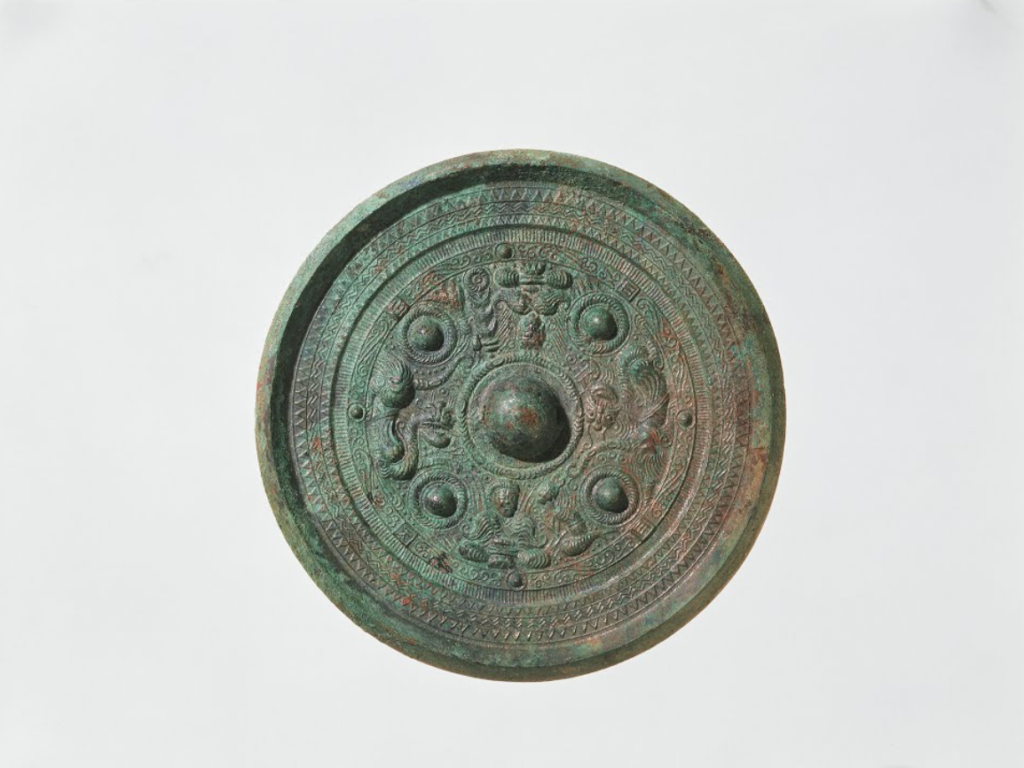
Creator: Unknown
Period: Kofun Period
Date: 3- 4th century
Culture: Japan
Medium: Bronze
Dimensions: 21. 5 cm long diameter
Classification: Unknown
Credit Line: Kyoto National Museum
Provenance: Higashinomiya Tumulus on Mount Hakusan in Aichi prefecture, Japan
Accession Number: Unknown
_________________________________________________________________________
URL/References: https://artsandculture.google.com/asset/bronze-mirror-decorated-with-triangular-rim-double-wave-patterned-band-gods-and-animals-unknown/rAHYmp4Bi8jzaw
http://emuseum.nich.go.jp/detail?content_base_id=101147&content_part_id=002&langId=en&webView=null
_________________________________________________________________________
Description:
This Bronze Mirror, which dates back to 3-4th Century, was found discovered in the Higashinomiya Tumulus on Mount Hakusan in Aichi prefecture in Japan. It was said according to archaeologists and historians that many bronze artifacts and objects during the first portion of the Kofun period were found at this site. The Bronze Mirror belonged to a collection and was just one of 11 that were produced. This mirror is far from ordinary and is rather striking with its array and repetitions of triangular and geometric circular ringed reliefs. Beyond these elaborate imprinted rings feature figures pertaining to animals, creatures, and divine beings which surround a large ball projecting from the mirror. These motifs were often referred to as hannikubori, which translates to “half body engraving.” On the mirror’s exterior, one can also make note of the various Chinese inscriptions which read “ten (heaven), ō (king), hi (sun) and tsuki (moon).”
Upon viewing these Chinese characters, meticulous designs, hannikubori, and most importantly the shape of the Bronze Mirror, we as viewers can assume that the mirror served more purpose than just a mirror. This mirror seems to bear a lofty significance as it might have been a symbol of power and an object of remembrance for one’s afterlife. The shape of the mirror is a circle which possesses the idea that life is cyclical, cosmic, and therefore infinite amidst a chaotic envrionment. There will always be cosmos and chaos in the earthly realm of mortals and heavenly realm of immortals and deities. The mirror bears this abundance of infinity where there are no boundaries and that there is a mystical transcendence which overpowers ends to a mean. This motif can be applied to one’s god given right and reign to power as well as one’s afterlife.
What resonates in mind when we hear the words divine circles/orbs? The sun, moon, planets, and stars. What do the sun, moon, and planets have in common with the mirror aside from being inscribed in it? They are in constant, cosmic motion. Each of these symbols directly relates to the heavens and the celestial, bodily realm. At times we associate these depictions with zodiacal astrological signs, mythological gods and creatures, and even fables and stories from classical antiquity. Interestingly, during the High Renaissance and even afterwards between the 14th and 18th centuries, many political and sovereign figures of power would equate themselves to the gods. By doing this, they felt that their rules and ideas were insurmountable and therefore godlike for no one could surpass them. This was also a way to distinguish their place in society. In a social hierarchy, they were at the top with affluence, sophistication and vigor, while everyone else who served them and bowed to them were the dirt under their feet. For instance, King Louis XIV always saw himself as Apollo, the “sun god” and felt that his right to power was granted to him by Apollo himself. He has many portraits and even ceiling paintings in Versailles commissioned of himself to appear like Apollo. This was a reminder to the French people and himself that he was in charge.
To conclude, the mirror was an object to be utilized for a harmonious and infinite afterlife with blessings from the gods and mythological creatures. The mirror, on the other hand, was an article full of triumph and remembrance for someone who boasted in high ranks among the lower echelons of people as they were destined for greater things.
By Isabella Di Scipio